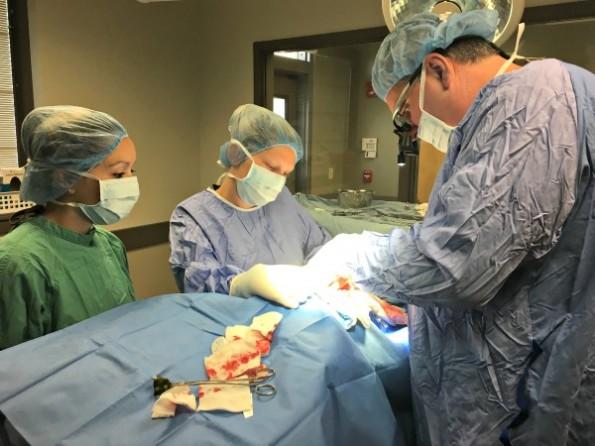
There are some clinics which are able to provide spay and neuter procedures at prices far lower than what full-service animal hospitals or clinics charge. Important differences exist in the value provided to the pet and pet-parents by these procedures, depending on where you go. Here are some of the differences in what is included that are responsible for the differences in cost to you, the pet owner.
1. Low-Cost Clinics Do Not Typically Require or Offer Pre-Surgical Bloodwork
At Winslow Animal Hospital, the safety of our patients is paramount. Anesthesia does have some risks, and we work to mitigate those risks by testing the blood prior to surgery.
Low-cost spay/neuter clinics often do not require bloodwork, operating under the assumption that most young, healthy animals do not have underlying metabolic issues. Most young pets will be ok, but bloodwork takes some of the guesswork out of the equation. Low-cost clinics may sometimes offer bloodwork for an additional fee.
2. Low-Cost Clinics Do Not Typically Place an IV Catheter or Give Intravenous Fluids to Your Pet During Surgery
An IV Catheter and fluids provide assistance with blood pressure stability and perfusion to organs (making sure the organs receive the flow of blood and nutrients). If your pet has problems with blood pressure, this could cause organ problems within days or weeks of the procedure. Most young, healthy animals will not have this problem, and the surgery in high-volume spay/neuter clinics is usually quick, but not always. If your hospital provides an IV Catheter, the cost of the procedure will go up.
3. Low-Cost Clinics Have Limited Staffing
One way to keep costs down is to employ fewer veterinary technicians. If all goes well, there are enough technicians to cover the needs of the pets. However, it is common for technicians to multi-task. If complications should arise for your pet, those complications usually appear in recovery. If your pet does have difficulty, it may not be noticed right away.
4. Low-Cost Clinics May Not Monitor CO2 levels, ECG, Blood Pressure, & Body Temperature Throughout Surgery
A pulse-oximeter is used to reveal heart rate and oxygen perfusion in the blood, which is important, but often other vital signs may not be. Hypothermia, heart abnormalities, blood pressure abnormalities, and abnormal CO2 levels can be missed, leading to complications. Most young, healthy pets will not experience these problems, especially during such a quick procedure, but it is still a risk. Monitoring for all these vitals increases costs.
5. Low-Cost Clinics Do Not Typically Provide a Full, Comprehensive Physical Exam & Vet Consultation for Your Pet Before Surgery
Exams are limited because so many surgeries are performed every day at low-cost clinics. This means you will probably not have the opportunity to discuss your pet’s health and concerns with a vet before the surgery. If your hospital provides time and opportunity for a comprehensive exam and discussion with your vet, your cost goes up along with that added value.
6. Low-Cost Clinics are not the Best Option for High-Risk Patients
Large breed dogs, senior pets, flat-nosed breeds, obese, and other higher-risk pets are more likely to experience emergencies during surgery. Low-cost clinics usually will not be as well-equipped for emergencies as full-service hospitals. These clinics are set up to handle normal, healthy, young patients that they can get in and out quickly. If your hospital is set up to handle a broader range of health problems, your cost will go up.


Nowadays more number of clinics are there to provide the spay and neuter facility. But due to some financial issue if you choose a low-cost clinic then it may risk for animal. Generally most of the low-cost clinic don’t do the pre-surgical testing and examination so that may create a problem. Low-cost clinic don’t have better surgery room and the surgical instruments are not fully sterilized. So it is not a good idea to prefer a low-cost clinic. Always you should prefer for your pet a veterinary clinic that do the early diagnosis, also the use the high quality surgical instrument.
All your points are very valid, but for people with pets who are on a fixed incime, have recently lost a job, or had an unexpected financial setback, how do we care for our animals? Or try to stabilize feral cat colonies? I have always used full veterinary care when possible, but now that i am unemployed and skimping to pay for pet food, with no credit cards and no veterinary payment plans, I am grateful for what low cost care I can get. (And thank you, Winslow Township, for free rabies clinics!)